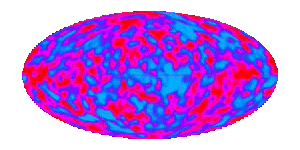

Perhaps the most conclusive, and certainly among the most carefully examined, piece of evidence for the Big Bang,
is the existence of an isotropic radiation bath that permeates the entirety of the Universe,
known as the "Cosmic Microwave Background" (CMB).
In 1964, two young radioastronomers, Arno Penzias and Robert Wilson,
almost accidentally discovered the CMB using a small (15 m), well-calibrated horn antenna.
It was soon determined that the radiation was diffuse, emanated uniformly from all directions in the sky,
and had a temperature of approximately 3 Kelvin.
Initially, the two young scientists were bereft of a satisfactory explanation for their observations,
and considered the possibility that the CMB may have been due to some undetermined systematic noise.
However, it soon came to their attention through Robert Dicke and Jim Peebles of Princeton
that this background radiation had in fact been predicted years earlier (in 1948)
by George Gamow, Ralph Alpher, and Robert Herman as a relic of the evolution of the early Universe.
Arno Penzias and Robert Wilson received the Nobel Prize in physics in 1978.
More history in abbreviated form is in this CMB Timeline.
If the Universe was once very hot and dense, the photons and baryons would have formed a plasma.
As the Universe expanded and cooled there came a point when the radiation (photons) decoupled from the matter (baryons).
The radiation cooled and is now at 2.73° Kelvin.
The fact that the spectrum (see figure) of the radiation
is almost exactly that of a "black body" implies that it could not have had its origin through any prosaic means.
This led to the death of the "Steady State" theory (Bondi, Gold, Hoyle, 1949).
Further investigations, including more recent ones by the COBE satellite (Smoot et al.), confirmed the virtual isotropy of the CMB to better than one part in ten thousand.
Given this qualification checked in limited regions by small angular scale observations, any attempt to interpret the origin of the CMB as due to present astrophysical phenomena (i.e. stars, radio galaxies, etc.) is discredited. Therefore, the only satisfactory explanation for the existence of the CMB lies in the physics of the early Universe.
While the CMB is predicted to be very smooth, the lack of features cannot be perfect. At some level one expects to see irregularities, or anisotropies, in the temperature of the radiation. These temperature fluctuations are the imprints of processes and features of the early Universe.
Usually the features of the Universe and the CMB are interpreted in the context of a cosmological model - The Big Bang -
which is derived from general Cosmological Principles and observations.
Some of the features of the Big Bang model are discussed in the page
Ripples in Space; the Origin of Structure in the Universe.
The original information for this page
can be found in the Web site of the Smoot Cosmology Group
John C. Mather and George F. Smoot, Nobel Prize in Physics 2006
(Nobel Foundation)
See
The Nobel Prize in Physics 2006
(.pdf).
See The Nobel Prize in Physics 1978
(Nobel Foundation)
![]() Updated: October 3 '06
Updated: October 3 '06
Best seen with MS Internet Explorer.
Back to: The Cosmic Microwave Background - A Relic from the Origin of the Universe (Basic Knowledge)